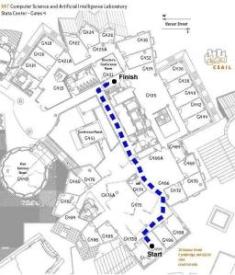The Stata Walking Guide: Generating Descriptive Walking Directions
Gary Look, Cyrus-Charles Weaver, Robert Laddaga & Howard Shrobe
Introduction
An expressive representation for location is an important component in many applications. However, while many location-aware applications can reason about space at the level of coordinates and containment relationships, they have no way to express the semantics that define how a particular space is used. We present LAIR, an ontology that addresses this problem by modeling both the geographical relationships between spaces as well as the functional purpose of a given space. To demonstrate LAIR's usefulness, we used it to build the Stata Walking Guide. This is an application that generates walking directions that are similar to those a person would give.
LAIR
LAIR is an ontology inspired by Ben Kuipers' TOUR model of a person's cognitive maps of large-scale spaces [1]. The TOUR model is based not just on metric distances but on higher-level concepts such as Places and Paths between Places. LAIR supplements the TOUR model by associating to each Place a description of its Functional Purpose. For example, a particular building may function as any of the following: grocery store, bank, or shoe store. A certain area of a building may be a meeting area, lounge, or kitchenette. Instances of locations modelled in LAIR are stored in a semantic network; this allows us to make inferences about the relationships between different Places and the Paths between them.
The Stata Walking Guide
To demonstrate how LAIR can be used in an application, we created the Stata Walking Guide. The Stata Walking Guide provides both a route map and written walking directions between different places in MIT's Stata Center. This application is especially useful for the Stata Center because many visitors (and current occupants!) find the building's irregular floorplan bewildering (see Figure 1 for an actual floorplan). The written directions produced with LAIR also include landmarks, in contrast to the type of directions produced by MapQuest, which only list a sequence of "goto" and "turn" instructions.
The Stata Walking Guide consists of two parts, a route-finding component that produces the graphical route map between two places and a translation component that converts the route information into written directions. The route-finding component uses A* search to produce a series of waypoints that represents a route from one place to another. The translation component then takes the series of waypoints and uses a set of rules to produce the written directions. These rules use information stored in LAIR to describe the hallway intersections and landmarks along a route.
Progress
We ran a pilot study to evaluate the subjective quality of the directions the Stata Walking Guide produces. In this study, seven volunteers, three women and four men, each of whom were not familiar with the Stata Center, were given a set of three route descriptions to follow.
After walking all three routes, participants filled out a questionnaire where they were first asked to subjectively rate the quality of each set of directions on a scale of 1 to 5, with 5 being the highest. They were then asked to compare the directions they received to human generated descriptions of the same routes. For each of the three routes, participants were asked whether the set of directions they followed were worse than, comparable to, or better than the second set of directions they were shown.
The results of the pilot study were promising. Routes 2 and 3 received high average scores: 4.0 and 4.4, respectively. For Route 2, 6 of the 7 participants rated the directions produced by the Stata Walking Guide as better than those produced by a person. This route is shown below, in Figure 1. For Route 3, 5 of the participants rated the two sets of directions as comparable and one participant considered the Stata Walking Guide's directions to be better than the directions produced by a person. A more complete discussion of the results of this study is found elsewhere [2].
Figure 1. The second route used in our pilot study. To the right of the route map are the directions the Stata Walking Guide produced. A person's description of the same route follows below that.
Future Work and Acknowledgements
We are currently working on deploying the Stata Walking Guide to OK-Net, the Stata Center's network of public information kiosks [3]. We also plan to use LAIR in a model of human decision making in mobile contexts. This research is supported by MIT's Project Oxygen.
References
[1] Benjamin. J. Kuipers. Representing Knowledge of Large-Scale Space. PhD thesis, Massachusetts Institute of Technology, July 1977. MIT AI/TR 418.
[2] Gary Look, Buddhika Kottahachchi, Robert Laddaga, and Howard Shrobe. A Location Representation for Generating Descriptive Walking Directions. In IUI '05: Proceedings of the 10th International Conference on Intelligent User Interfaces, pp. 122-129, San Diego, CA, USA, January 2005.
[3] Max Van Kleek. Intelligent Environments for Informal Public Spaces: the Ki/o Kiosk Platform. Masters of Engineering thesis, Massachusetts Institute of Technology, February 2003.
The Stata Center, Building 32 - 32 Vassar Street - Cambridge, MA 02139 - USA tel:+1-617-253-0073 - publications@csail.mit.edu (Note: On July 1, 2003, the AI Lab and LCS merged to form CSAIL.) |

